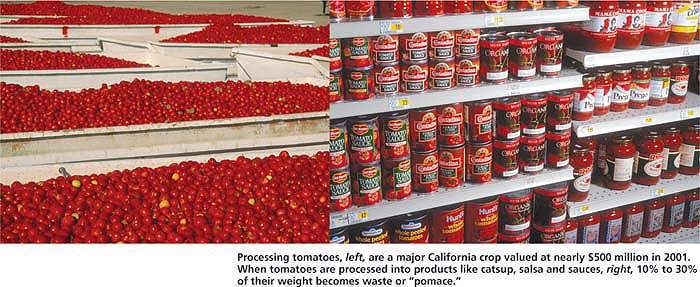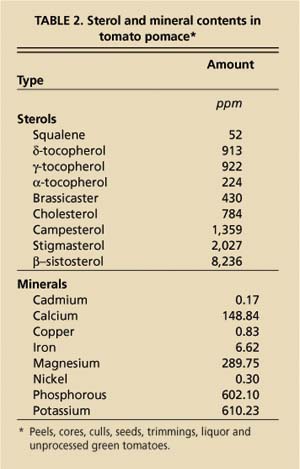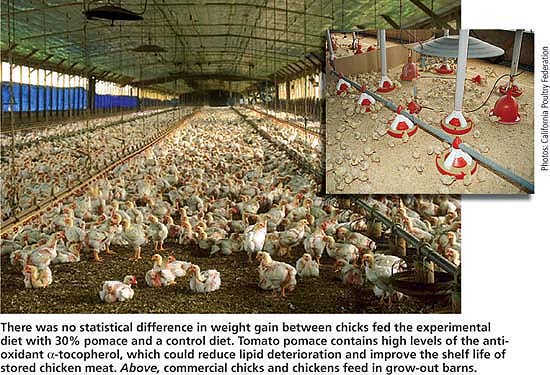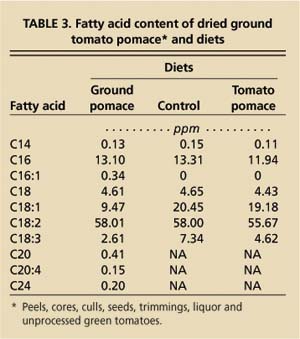All Issues
Tomato pomace may be a good source of vitamin E in broiler diets
Publication Information
California Agriculture 58(1):59-62. https://doi.org/10.3733/ca.v058n01p59
Published January 01, 2004
PDF | Citation | Permissions
Abstract
Dried tomato pomace, a byproduct of tomato processing, is an excellent source of $$alpha$$-tocopherol (vitamin E), which is used as an antioxidant in broiler meat. In a feeding study, there were no significant differences in body weight and feed per gain in chicks given diets with or without tomato pomace. Tomato pomace could be used as a source of $$alpha$$-tocopherol in broiler diets to decrease lipid oxidation (fat deterioration) during heating and long-term frozen storage of dark meat, and to prolong shelf life. Because tomato byproducts contain high levels of unsaturated fatty acids, the pomace must be defatted without losing vitamin E to minimize its oxidation potential. Although we found no evidence that introducing a high-fiber feed ingredient significantly limited broiler growth, more research is needed to enhance its practical applications.
Full text
Processing tomatoes, left, are a major California crop valued at nearly $500 million in 2001. When tomatoes are processed into products like catsup, salsa and sauces, right, 10% to 30% of their weight becomes waste or “pomace.”
IN 2001, California farmers grew about 258,000 acres of processing tomatoes (USDA-NASS 2002), which are made into juice and concentrated products such as catsup, salsa, paste, puree, soups and sauces. About 10% to 30% of the raw tomato weight becomes waste, part of which is hauled fresh to nearby cattle and dairy farms and sold for a token fee. Tomato waste (pomace) consists of peels, cores, culls, seeds, trimmings, liquor and unprocessed green tomatoes picked by harvest machinery.
The composition of tomato pomace varies according to agricultural and processing practices, the degree of drying, moisture removal and separation of cellulose. Tomato pomace can contain up to 25% high-lysine protein and 242 parts per million (ppm) of $$alpha$$-tocopherol (vitamin E). Tomato pomace is recommended for cattle and dairy cow feed due to the ability of these animals to digest fiber. Likewise, tomato seeds are recommended as a source of protein isolate in food applications for humans (Kononko et al. 1986; Cantarelli et al. 1989). However, the high temperatures used to process tomatoes may affect protein extractability (Canella and Castriotta 1980).
Depending on the processing method, pomace can contain more than 31% fiber. Because high-fiber pomace (31%) is not easily digested by broilers and can dilute the available energy content of the feed, it has been used at less than 5% in the diets of these meat-type chickens. Because laying hens need less protein and are able to digest fiber, the potential use of tomato pomace in their feed is estimated as high as 15% (A. Mireles, Nutritionist/Feed Research Manager, Foster Farms, Livingston, Calif., personal communication).
The levels of $$alpha$$-tocopherol in tomato pomace may be particularly useful in feeds for meat animals. Tocopherols, especially the alpha ($$alpha$$) form, help prevent lipid oxidation (deterioration of fats). They preserve the quality of heated or stored meat by reducing the end products of oxidation that cause discoloration, off odors and off flavors. Also, some byproducts of lipid oxidation may be hazardous to human health.
Because the California broiler industry had a total value of about $472 million in 1997 and results from this experimental animal can be obtained at an earlier age than for laying hens, young broiler chicks were used in this study. A previous study showed that fortification of broiler diets with 150 ppm $$alpha$$-tocopherol per kilogram feed for 3 to 6 weeks maintained 10 ppm of $$alpha$$-tocopherol in postmortem meat, enough to retard lipid oxidation by up to 50% during refrigerated and frozen storage (King et al. 1995). Other investigators have shown that vitamin C and vitamin E improved feed conversion, layer performance and the effect of heat by terminating free-radical attacks and promoting greater thyroid activity, ultimately increasing the immune response (Whitehead et al. 1998; Bollenger-Lee et al. 1999; Sahin and Kucuk 2001; Sahin, Kucuk et al. 2002; Sahin, Sahin et al. 2002). Previous research suggests that an agricultural waste product containing ample amounts of $$alpha$$-tocopherol could be added to feed to produce a value-added meat product.
At their UC Davis laboratory, the researchers studied the potential use of tomato pomace in feed for broiler chickens. Above, postdoctoral researcher Jamal Assi displays pomace. Right, second-stage pomace is bottom value after cooking (BVAC) that has been macrofiltered and sun-dried. It contains about 50% tomato seeds.
We studied tomato pomace in chicken diets to determine if $$alpha$$-tocopherol in the pomace would retard lipid oxidation in stored meat, and if pomace containing about 26% fiber significantly affected bird weights at 3 weeks of age. The fiber content in our experimental diet was about 10 times greater than that used for practical feeding regimens; as such, the results provide information about the possible use of tomato pomace but cannot be applied to practical situations.
Feed formulation
We obtained pomace from four tomato varieties (Halley, Heinz 8895, Brigade and Heinz 3044) commonly grown in the Sacramento Valley. Pomace is produced from the bottom volume after cooking (BVAC), the primary end-residue from the processing line. Second-stage pomace is BVAC that is macrofiltered for large stems and leaves before sun drying. Second-stage pomace, obtained from a local tomato processing company, was transported to the laboratory within 24 hours after drying and stored at 44.6°F. Immediately after each pomace batch was received, we analyzed at least two samples for moisture, fat, protein, crude fiber, minerals, sterols, fatty acids and pesticides (carbaryl carbamates, organochlorines and organophosphates).
Results from the initial analyses of dried pomace were incorporated into a database, which was used to formulate the control and experimental diets utilizing the Mix-it computer program to determine least-cost feed formulations. To maximize any effects of tomato pomace supplementation, a maximum amount was incorporated into test feed, resulting in unusually high fiber contents. To minimize this fiber effect, control diets were supplemented with cellulose to allow similar fiber composition across the tests. While no significant short-term effects due to high-fiber feeds have been described in the literature, such feeds are not typical in the industry due to concerns that they may restrict growth.
The control and pomace diets were formulated to meet or exceed the minimum nutrient requirements of poultry (table 1). Ground tomato pomace (224 ppm $$alpha$$-tocopherol) was added at 30% of the diet. Tomato pomace partially replaced soybean meal, cellulose and glucose and provided about 76 ppm vitamin E as a calculated value from components listed in table 1. The control diet contained about 29 ppm of vitamin E. Protein, fat (predominately from rendered chicken fat) and fiber were 22%, 8.0% and 7.0%, respectively, for both diets. The fatty acid content of both diets was determined at the beginning of each feeding trial.
Broiler feeding trials
For both feeding trials, 1-day-old male Arbor Acre Cross chicks were obtained from a local producer, banded and distributed randomly into groups, and placed into pens positioned in electrically heated batteries with raised wire floors. Birds were housed in a windowless room at 73.4°F and 14 hours of light per day. Feed and water were administered on demand. Weight gain was recorded twice weekly. The study was conducted over two consecutive summers in 1994 and 1995. During the first week of the first trial, six groups of five birds were fed the control diet. For the following 2 weeks, the control or experimental diet was fed to three groups (replications) of five birds. The entire feeding trial was repeated with eight groups of six birds following the same procedure. Thirty-nine birds each (15 from the first and 24 from the second trial) were fed the control or experimental diet.
Measuring lipid deterioration, expressible moisture
At the end of each trial, chicks were humanely slaughtered. Thigh meat was removed and pooled by treatment. It was frozen immediately in liquid nitrogen and stored at -185°F. Meat from both treatments was thawed for 1 hour at 73.4°F, then ground and analyzed immediately or after 4 days of storage (30.2°F) for thiobarbituric acid reactive substances (TBARS) — four samples for each replication (Salih et al. 1987) — as an indicator of lipid deterioration and percent expressible moisture (%EM, three samples for each replication).
Malonaldehyde, a byproduct of lipid deterioration, was extracted from meat. During heating, thiobarbituric acid was reacted with malonaldehyde to produce a solution ranging from pink to red, indicating the level of byproducts (mostly malonaldehyde) in the meat. The color was measured spectrophotometrically.
There was no statistical difference in weight gain between chicks fed the experimental diet with 30% pomace and a control diet. Tomato pomace contains high levels of the anti-oxidant $$alpha$$-tocopherol, which could reduce lipid deterioration and improve the shelf life of stored chicken meat. Above, commercial chicks and chickens feed in grow-out barns.
Analysis for %EM measured the amount of moisture expressed from meat by centrifugal force (Earl et al. 1996). The %EM was calculated as the weight of moisture expressed divided by the original weight of meat, and is related to the quality of protein in the meat. When protein in meat is damaged due to chemical processes or lipid deterioration during storage, the meat fails to retain water. In general, the higher the %EM, the lower the overall functional (protein) quality of the meat.
Statistical analysis
Mean values were determined for each item in the initial analysis. An analysis of variance was conducted on the data for weight gain, feed efficiency, fatty acid content of diets, TBARS and %EM. Duncan's new multiple range test was used to measure the significance of differences at P < 0.05.
Pomace in poultry diets
The tomato pomace used in this study contained 5.05% moisture, 11.93% fat, 26.88% protein and 26.30% crude fiber. The fiber content is within the range of results reported by other investigators. The content of ß-carotene and selected sterols and minerals is shown in table 2.
Fatty acids contents were similar except that linolenic acid (C18:3) was statistically greater in the control diet (7.34 ppm) than in the tomato pomace diet (4.62 ppm)(table 3). Linolenic acid can increase lipid deterioration in feed and poultry meat.
Carbamate, organochlorine and organophosphate pesticides are known to be harmful to poultry and humans. These three pesticides were below detectable levels in the tomato pomace we tested.
Weight gain
Weight gain for birds fed the experimental diet (801 grams) was statistically similar to that of birds fed the control (743 grams) at P < 0.05. Feed conversions (weight gain divided by feed consumed [grams]) of 1.6 and 1.8 for the control and tomato pomace diets, respectively, were also similar at P < 0.05. Our results contrast with those of other investigators who reported that feeding 22.94% crude fiber (tomato seed meal) at 34% of the diet depressed growth by about 13% in 4-week-old chicks when compared to those consuming cotton seed meal (El Moghazy and El Boushy 1982). However, our results are similar to those of Squires et al. (1992), who showed that feeding up to 20% untreated tomato cannery waste had no significant effect on measured production parameters.
Although not statistically different, a detrimental effect in feed conversion of 0.20 would translate into an increase in feed consumption of 1 pound per bird at market weight and a subsequent loss of $500,000 per year for the California broiler industry, which would be unacceptable (A. Mireles, Nutritionist/Feed Research Manager, Foster Farms, Livingston, CA, personal communication). Squires et al. (1992) suggest that alkali treatment of pomace may improve nutrient digestibility, decreasing the potential detrimental effects of supplementation.
Lipid oxidation, expressible moisture
For each storage condition, TBARS values — indicators of lipid deterioration levels — were similar for the uncooked meat of broilers fed the pomace and control diets. After 4 days of refrigerated storage, the TBARS value for meat from the control (1.23) was about 23.0% higher than from the pomace diet. This trend suggests a significant antioxidative effect for $$alpha$$-tocopherol from tomato pomace in meat heated before or after storage (for example, a maximum of 7 days at 39.2°F to 44.6°F or more than 2 weeks at -68°F).
Investigators have shown that by-products from fat deterioration associate with protein to change functional properties like %EM. Our study showed that %EM was not significantly different in meat from birds fed pomace (47.27%) and the control (51.52%). This finding seems to support the results for TBARS values. Although TBARS and %EM were statistically similar for both diets, the values for diets containing tomato pomace were always numerically lower. In a preliminary study (data not shown) in which lipid oxidation was accelerated by heat and pro-oxidants, TBARS values for the meat from birds fed pomace were significantly lower (30%) than the control. These findings indicate that some combination of tomato pomace — as a useful waste product — and $$alpha$$-tocopherol would be beneficial to prevent lipid oxidation in stored unheated and heated poultry meat. Ultimately, the added value of using tomato pomace for its $$alpha$$-tocopherol content must be assessed relative to its fiber content.
A promising vitamin E source
When tomato pomace was fed to broilers at 30% of the diet, growth was not significantly decreased. Though not significant, the decrease in feed efficiency (0.2) that is economically restrictive may be corrected with heat treatment and by lowering the available nutrient composition of tomato pomace.
Alpha-tocopherol is mainly found in tomato seeds. Microscopic analysis showed that tomato pomace contains about 50% tomato seed. If seeds were separated and fed to growing broilers in combination with pomace (not to exceed an excessive fiber level that could significantly retard growth) more $$alpha$$-tocopherol could be added to diets, possibly substantially reducing lipid deterioration in heated or stored poultry meat. Additional research will determine the lowest amount of pomace and seed that could be fed to achieve the desired antioxidant effect with no decrease in weight gain.











